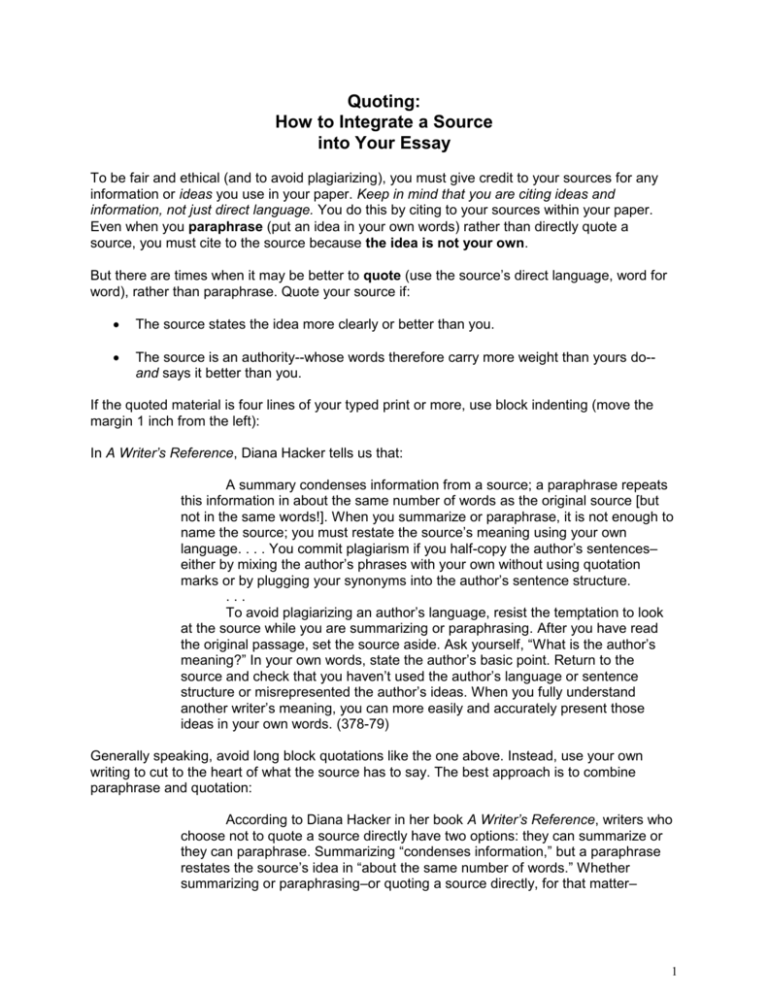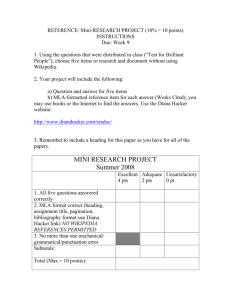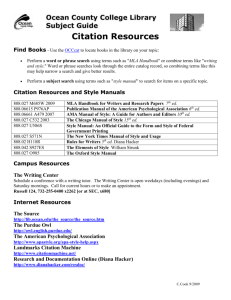According to Diana Hacker, a research paper is a "collaboration
advertisement

Quoting: How to Integrate a Source into Your Essay To be fair and ethical (and to avoid plagiarizing), you must give credit to your sources for any information or ideas you use in your paper. Keep in mind that you are citing ideas and information, not just direct language. You do this by citing to your sources within your paper. Even when you paraphrase (put an idea in your own words) rather than directly quote a source, you must cite to the source because the idea is not your own. But there are times when it may be better to quote (use the source’s direct language, word for word), rather than paraphrase. Quote your source if: The source states the idea more clearly or better than you. The source is an authority--whose words therefore carry more weight than yours do-and says it better than you. If the quoted material is four lines of your typed print or more, use block indenting (move the margin 1 inch from the left): In A Writer’s Reference, Diana Hacker tells us that: A summary condenses information from a source; a paraphrase repeats this information in about the same number of words as the original source [but not in the same words!]. When you summarize or paraphrase, it is not enough to name the source; you must restate the source’s meaning using your own language. . . . You commit plagiarism if you half-copy the author’s sentences– either by mixing the author’s phrases with your own without using quotation marks or by plugging your synonyms into the author’s sentence structure. ... To avoid plagiarizing an author’s language, resist the temptation to look at the source while you are summarizing or paraphrasing. After you have read the original passage, set the source aside. Ask yourself, “What is the author’s meaning?” In your own words, state the author’s basic point. Return to the source and check that you haven’t used the author’s language or sentence structure or misrepresented the author’s ideas. When you fully understand another writer’s meaning, you can more easily and accurately present those ideas in your own words. (378-79) Generally speaking, avoid long block quotations like the one above. Instead, use your own writing to cut to the heart of what the source has to say. The best approach is to combine paraphrase and quotation: According to Diana Hacker in her book A Writer’s Reference, writers who choose not to quote a source directly have two options: they can summarize or they can paraphrase. Summarizing “condenses information,” but a paraphrase restates the source’s idea in “about the same number of words.” Whether summarizing or paraphrasing–or quoting a source directly, for that matter– 1 Hacker warns the writer to cite to the source. Otherwise, the result is plagiarism (378-79). Use the author’s full name (as given on the title page) when you first mention the author in your text. But use only the last name in a parenthetical, even if it’s the first mention. Make sure the quoted material fits grammatically into your sentence structure. To integrate a quotation, the writer must “condense[] information from a source” so that it fits smoothly (and grammatically) into the sentence (Hacker 378). Never let a quotation stand alone; always make it part of your sentence. Use a signal phrase. Not: “When you fully understand another writer’s meaning, you can more easily and accurately present those ideas in your own words.” (Hacker 379). But: Diana Hacker advises this: “When you fully understand another writer’s meaning, you can more easily and accurately present those ideas in your own words” (379). Quotation Marks In American English, periods and commas go inside quotations; semicolons and colons go outside. Question marks and exclamation points go in or out, depending on what part of the sentence they belong to. Hamlet says, “To be or not to be; that is the question.” Does Hamlet say, “To be or not to be”? “Ask your Mom!” she yelled. She asked, “Will you finish in time?” She said she was “finished,” but I’m not sure when she’ll get here. She said she was “finished”; however, I’m not sure when she’ll get here. 2 Use brackets ( [ ] ) to indicate that you have changed quoted material. Use ellipses ( . . . ) to indicate that you have omitted quoted material–but not at the beginning or end of the quoted material. Diana Hacker says, “To avoid plagiarizing an author’s language, resist the temptation to look at the source while you are summarizing or paraphrasing” (379). Hacker says, “[R]esist the temptation to look at the source while you are … paraphrasing” (379). To indicate that the error is in the original material, not in yours, use this symbol: [sic]. Original: It dosn’t matter what we call it. Quotation: She wrote, “It dosn’t [sic] matter what we call it.” MLA Documentation Style The citation examples in this handout follow MLA (Modern Language Association) documentation style. In that style, the citation in your sentence, whether in a signal phrase or parenthetical, must correspond to the first word in the Works Cited entry. The Hacker citations that appear above would correspond to this WC entry: Works Cited th Hacker, Diana, and Nancy Sommers. A Writer’s Reference. 7 ed. Boston: Bedford, 2011. Print. Note the “hanging indent” style of the entry. In Word 2010, here’s how to get the hanging indent. With your cursor on the entry (or with all the entries highlighted at once): 1. 2. 3. 4. 5. Click the Home ribbon. Select Paragraph. Look for the “Special” dropdown menu, and select Hanging. The Hanging option should default to 0.5. If it does not, change it to 0.5. Click OK. For more information about Works Cited, visit the MLA section of your Hacker reference and check out the resources at this site: http://ww2.nscc.edu/singletary_m. 3 Quotation Examples Original (This is the soliloquy from the narrator, Tom, in Scene 7 of Tennessee Williams’ play The Glass Menagerie.) I didn't go to the moon, I went much furtherfor time is the longest distance between two places. Not long after that I was fired for writing a poem on the lid of a shoebox. I left Saint Louis, I descended the steps of this fire-escape for a last time and followed, from then on, in my father's footsteps, attempting to find in motion what was lost in space. I travelled around a great deal. The cities swept about me like dead leaves, leaves that were brightly coloured but torn away from the branches. I would have stopped, but I was pursued by something. It always came upon me unawares, taking me altogether by surprise. Perhaps it was a familiar bit of music. Perhaps it was only a piece of transparent glass. Perhaps I am walking along a street at night, in some strange city, before I have found companions, I pass the lighted window of a shop where perfume is sold. The window is filled with pieces of coloured glass, tiny transparent bottles in delicate colours, like bits of a shattered rainbow. Then all at once my sister touches my shoulder. I turn around and look into her eyes. Oh, Laura, Laura, I tried to leave you behind me, but I am more faithful than I intended to be! I reach for a cigarette, I cross the street, I run into the movies or a bar, I buy a drink, I speak to the nearest strangeranything that can blow your candles out! For nowadays the world is lit by lightning! Blow out your candles, Lauraand so good-bye. Quoting a sentence from the original: Tennessee Williams has his character Tom tell the audience, "I didn't go to the moon, I went much further" (Scene 7). Note that the parenthetical above uses “Scene 7” to denote what part of this seven-scene play the line comes from. If we were quoting from a book or journal instead of a play, we would assume the number referred to a page as in the examples at the top of this file. Quoting part of a sentence and changing quoted language: Tom tells the audience that he "didn't go to the moon, [he] went much further" (Williams 7). Paraphrasing the original: In his final soliloquy to the audience, Tom describes running away from home, but he explains that he was nevertheless unable to completely escape his family (Williams 7). Paraphrasing and partly quoting: In his final soliloquy to the audience, Tom describes running away from home, but he explains that he was nevertheless "pursued by something." Tom was never able to completely escape his family (Williams 7). Paraphrasing and quoting while omitting quoted language: "Oh, Laura, Laura, I tried to leave you behind me," says Tom in his final speech to the audience. But he was never able to fully escape his family and always felt that he had deserted his sister. He is "more faithful" than he meant to be: "I reach for a cigarette, I cross the street, . . . I buy a drink . . . anything that can blow your candles out"anything that can help him forget his past and the sister he left behind (Williams 7). (Thanks to Michelle Adkerson for this handout.) 4




